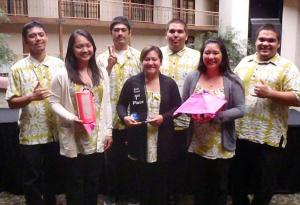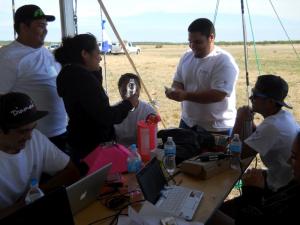
Kapi’olani CC Cansat team.
By Staff Reports
(Honolulu)– Kapi’olani Community College’s Cansat team took home the top prize for designing, building and launching a space-related mission at the annual Cansat International Competition held on June 7-9 in Abilene, TX. Known as Team Mod 6, Kapi’olani CC students prepared for eight months for this final showdown in Texas, out-performing stiff competition from top universities from Iran, Canada, India and the United States.
A reception honoring the winners was held on Friday, June 14 at 5:30 p.m. at Kapi’olani Community College STEM Center, Koki’o 202.
Chancellor Leon Richards proudly received the news and congratulated the team on its monumental win. “Having an intrepid leader at the helm makes the team indomitable,” said Chancellor Richards. “The College applauds the team’s hard work and courage to stand up to stiff competition.”
According to the team’s faculty advisor and Kapi’olani CC professor Hervé Collin, these students went through a complete engineering design process. First, he said, they presented a Preliminary Design Review (PDR), a 100-page document describing their design, to NASA judges last January. Then, they presented in March a Critical Design Review (CDR), a description of the progress of building and testing the designed and/or modified system. Finally, they launched their final payload on a rocket flying at about 2000 feet in the atmosphere somewhere above Texas. Then, they gave a Post Flight Review (PFR) presentation aimed at reporting a complete post-flight analysis describing all the telemetry data gathered during the actual flight.
“Most of the students in the Cansat team are students recruited through our summer bridge program sponsored by one of Kapi’olani’s grants from the National Science Foundation,” said Collin. “The summer bridge program’s goal is to increase the number of Native Hawaiian students into the STEM fields.”
Members of the 2013 Cansat team are Diamond Tachera, Kelsey Kawaguchi, Rae-zan Raposas, Joshua Tamayo, Logan Tamayo, McClyde Gaborno and Taylor Viti.
Collin added that this year’s payload was designed using a CAD software and built using Kapi’olani’s newly acquired 3D printer. “They had to decompose their project into specific subsystems: programming, electronics, telemetry, physical layout, descent rate, and deployment mechanism,” he said.
The project was supported by the National Science Foundation, Space Grant Hawai’i, and in collaboration with Windward Community College, which provided support to the Kapi’olani team with two test launches.
For more information, contact Herve Collin at (808) 734-9265 or visit the STEM Center website at http://stem.kcc.hawaii.edu.
About Cansat: Cansat is an international competition sponsored by the American Astronautical Society (AAS), the American Institute of Aeronautics and Astronautics (AIAA), and NASA that offers the opportunity to participating teams to design, build and launch a space-related mission.


